|
 Russula atroviridis Russula atroviridis
SynonymsRussula atrovirens
BiostatusPresent in region - Indigenous. Endemic
Images (click to enlarge)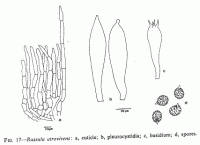 | 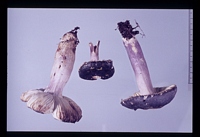
Caption: C-3754
Owner: Herb. PDD | 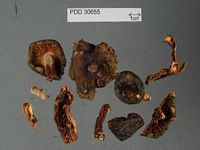
Caption: Dried type specimen
Owner: Herb PDD | 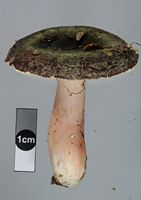
Owner: J.A. Cooper | 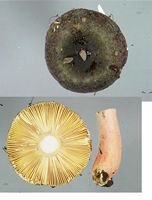
Owner: J.A. Cooper | 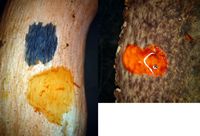
Caption: Top left: guaiac. Bottom left: FeSO4. Right: KOH on cap
Owner: J.A. Cooper | 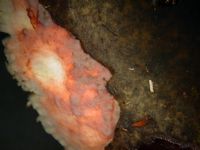
Caption: cap subcuticle
Owner: J.A. Cooper | 
Owner: J.A. Cooper | |
Article: McNabb, R.F.R. (1973). Russulaceae of New Zealand. 2. Russula Pers. ex S.F. Gray. New Zealand Journal of Botany 11(4): 673-730 (http://www.rsnz.org/publish/abstracts.php).
Description: pileus: 3.5-6.5 cm diam., hemispherical or convex when young, centrally depressed at maturity,
slightly to moderately viscid, glabrous, innately subpruinose under lens, velar
remnants absent, often multicoloured, dull greyish magenta with greenish yellow
or dark brown patches, sordid greyish green, or sooty grey with sordid greenish
tints, often with dull yellowish patches particularly toward centre, greyish
green colours predominating in dried specimens; margins entire, moderately thin,
non-pectinate. Cuticle 75-100 µm, thick, composed of erect, hyaline, thin-walled,
septate, hair-like hyphae 2-5 µm, diam., without coloured contents in KOH, terminal
cells unspecialised, often with acuminate or irregularly acuminate apices, occasionally
projecting to 50 µm beyond general level of cuticle, becoming disorganised and
partially gelatinised with age; pilocystidia absent. lamellae: adnate, crowded, moderately thick, simple or occasionally forked
near stipe, to 5 mm deep, white to pallid creamy white, not discoloured at maturity,
lamellulae rare Or absent. stipe: 2-4 cm long, ± equal, 1-1.5 cm diam.,
dry, solid, finely furfuraceous under lens, pallid greyish magenta, pallid rose,
or pallid sooty grey, flesh white, unchanging on exposure to air. Cuticle composed
of interwoven hyphae 2.5-5 µm diam., terminal cells projecting and often aggregated
into clumps. spores: spore print not obtained; spores broadly
elliptical, obliquely apiculate, apiculus to 1.5-(2) µm long, 7.5-10.5 X 7-9
µm, ornamentation of moderately dense amyloid verrucae to 0.7-(l) µm high, in
confluent groups and forming nodulate bands, joined by fine amyloid ridges and
forming an incomplete reticulum, or occasionally isolated; plage distinct. hymenium: basidia hyaline, clavate, 39-52 X 10-13.5
µn, 4-spored, sterigmata to 8 µm long: pleurocystidia scattered, numerous, broadly
fusiform or subclavate, hyaline, thin-walled, contents refractive in KOH, projecting
to 15 µm beyond basidia, apices bluntly acuminate, acuminate or apiculate, 52-78
X 8-13.5 µm, cheilocystidia numerous, similar to pleurocystidia but shorter.
hymenophoral trama:
heteromerous, inter-mixed, oleiferous hyphae present. context
of pileus: white, unchanging;
structure heteromerous, clamp connections absent. taste: lamellae and context mild. chemical characters:
formalin on context—n.r.; phenol on context—slowly deep vinaceous; FeSO4
on context—rapidly salmon pink; guaiacol on stipe base—n.r.: KOH on pileus—bleaching
action leaving area orange-red; on context—n.r.; NH4OH on pileus—green; on context
—n.r.
Habitat: Solitary or gregarious under Nothofagus.
Notes: Russula atrovirens also gives a distinctive green colour reaction
of the pileus to NH4OH and the spores are densely verrucose. It belongs in section
Rigidae Fr. and is possibly best placed in subsection Amoeninae
Sing. as defined by Singer ( 1962).
Considerable variation in colours of both pileus
and stipe occurs in this species. The green colours of the pileus are not always
dominant in fresh material, but quickly appear when fructifications are dried.
|